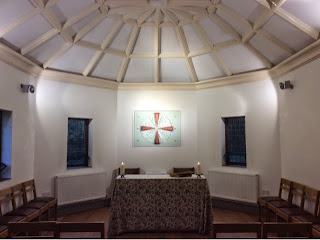William Glynne Charles Gladstone (Will) 1885-1915, the son of William Henry Gladstone, eldest son of Willam Ewart Gladstone the eminent Victorian statesman.
As mentioned below, during
a recent stay at Gladstone’s Library in
Hawarden, Flintshire, I went to view a WW1 exhibition in St Deiniol’s church which is next to the
Library. I was interested to see that there was a board on the Royal Welch Fusiliers.
As well as learning more about Robert Graves’s regiment, which recruited primarily from
North Wales, I was delighted to find that R G had known Gladstone’s
grandson, also a Royal Welch Fusilier, and had attended his funeral in Hawarden in 1915. After looking round the exhibition, I went back to the Library to
find a copy of Goodbye to All That and locate the passage where he is mentioned:
From Goodbye to All That:
“Of the officers sent out before me, several had already
been killed or wounded. The killed included a Liberal M.P., Second-Lieutenant
W. G. Gladstone, whom we called ‘Glad Eyes’. He was in his early thirties, a
grandson of old Gladstone, whom he resembled in feature, and Lord-Lieutenant of
his county. While war hung in the balance he declared himself against it,
whereupon his Hawarden tenantry, much ashamed, threatened to duck him in the
pond. Realising that, once war was declared, further protest would be useless,
he joined the regiment as a second-lieutenant. His political convictions
remained unaltered, but, being a man of great integrity, he refused to take the
non-combative employment as a staff-colonel offered him in the War Office. Soon
after joining the First Battalion in France he was killed by a sniper while
unnecessarily exposing himself. General French sent his body home for a
military funeral at Hawarden; I attended it.”
(GTAT, Penguin Books, 1985, p 66)
I was told by the head of the Tourism Committee of St
Deiniol’s Church, who had organised the exhibition, that William Glynne
Gladstone was particularly tall so that when he was standing in the trench his head was
above the parapet. The sergeant told him to duck down but he said “I can’t do
that. The men will think I’m in a funk”. Consequently he was shot. She also
told me that, although it was usual for officers to be buried with their men, a
special dispensation from the king allowed him to be brought home to be buried
in the churchyard at Hawarden. Here are some photos from the exhibition:
The body of W. G. C.
Gladstone in the Temple of Peace, Hawarden Castle
Lieutenant Gladstone’s body, drawn by estate people, leaving Hawarden Castle through the park his grandfather loved so well
Brothers-in-Arms pay
their Tribute in the churchyard.
The last scene in the
peaceful old churchyard. All the villagers were there to mourn the young
soldier squire.
I had hoped to be able to identify Robert in the photos but
they aren’t detailed enough. Still, it was good to think that he is there in
them somewhere.
Unfortunately the name of the member of the Tourism
Committee of the church who provided these photographs and the information is
obscured by poppies in the photograph I took of the complete board, but I am
grateful to him or her for their research.























